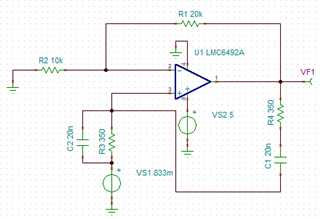Other Parts Discussed in Thread: LM2904, OPA333
HI.
Wien bridge oscillator circuit using LMC6492 is as follows.

However, there are cases where it does not actually work, and there are cases where it does.(Even when LMC6492 was replaced with LM2904 in the non-working sample, it did not work.)
Q1) Simulating with Ti TINA does not work. The sample doesn't work either. I would like to know the cause of it not working.
Q2) There is also a working sample. I want to know why samples are working and not working.
Q3) An output of approximately 20kHz is required. What parts do I need to modify to work?
Q4) An output of 40kHz is required. Can I use the LMC6492 as is? If it is not appropriate, please recommend OPAMP.
All/any help is very appreciated.


